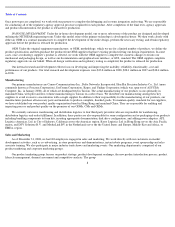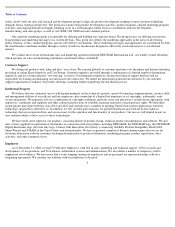Netgear 2008 Annual Report Download - page 17
Download and view the complete annual report
Please find page 17 of the 2008 Netgear annual report below. You can navigate through the pages in the report by either clicking on the pages listed below, or by using the keyword search tool below to find specific information within the annual report.
Table of Contents
inventory in a timely manner, if at all, or, alternatively we could end up with too few products and not be able to satisfy demand. This problem is
exacerbated because we attempt to closely match inventory levels with product demand leaving limited margin for error. If these events occur,
we could incur increased expenses associated with writing off excessive or obsolete inventory, lose sales, incur penalties for late delivery or have
to ship products by air freight to meet immediate demand incurring incremental freight costs above the sea freight costs, a preferred method, and
suffering a corresponding decline in gross margins.
Our business is subject to the risks of international operations.
We derive a significant portion of our revenue from international operations. As a result, our financial condition and operating results
could be significantly affected by risks associated with international activities, including economic and labor conditions, political instability, tax
laws (including U.S. taxes on foreign subsidiaries), and changes in the value of the U.S. dollar versus local currencies. Margins on sales of our
products in foreign countries, and on sales of products that include components obtained from foreign suppliers, could be materially adversely
affected by foreign currency exchange rate fluctuations and by international trade regulations.
The average selling prices of our products typically decrease rapidly over the sales cycle of the product, which may negatively affect our
gross margins.
Our products typically experience price erosion, a fairly rapid reduction in the average unit selling prices over their respective sales cycles.
In order to sell products that have a falling average unit selling price and maintain margins at the same time, we need to continually reduce
product and manufacturing costs. To manage manufacturing costs, we must collaborate with our third party manufacturers to engineer the most
cost-effective design for our products. In addition, we must carefully manage the price paid for components used in our products. We must also
successfully manage our freight and inventory costs to reduce overall product costs. We also need to continually introduce new products with
higher sales prices and gross margins in order to maintain our overall gross margins. If we are unable to manage the cost of older products or
successfully introduce new products with higher gross margins, our net revenue and overall gross margin would likely decline.
We are currently involved in various litigation matters and may in the future become involved in additional litigation, including
litigation regarding intellectual property rights, which could be costly and subject us to significant liability.
The networking industry is characterized by the existence of a large number of patents and frequent claims and related litigation regarding
infringement of patents, trade secrets and other intellectual property rights. In particular, leading companies in the data communications markets,
some of which are competitors, have extensive patent portfolios with respect to networking technology. From time to time, third parties,
including these leading companies, have asserted and may continue to assert exclusive patent, copyright, trademark and other intellectual
property rights against us demanding license or royalty payments or seeking payment for damages, injunctive relief and other available legal
remedies through litigation. These include third parties who claim to own patents or other intellectual property that cover industry standards that
our products comply with. If we are unable to resolve these matters or obtain licenses on acceptable or commercially reasonable terms, we could
be sued or we may be forced to initiate litigation to protect our rights. The cost of any necessary licenses could significantly harm our business,
operating results and financial condition. Also, at any time, any of these companies, or any other third party could initiate litigation against us, or
we may be forced to initiate litigation against them, which could divert management attention, be costly to defend or prosecute, prevent us from
using or selling the challenged technology, require us to design around the challenged technology and cause the price of our stock to decline. In
addition, third parties, some of whom are potential competitors, have initiated and may continue to initiate litigation against our manufacturers,
suppliers, members of our sales channels or our service provider customers, alleging infringement of their proprietary rights with respect to
existing or future products. In the event successful claims of infringement are brought by third parties, and we are unable to obtain licenses or
independently develop alternative technology on a timely basis, we may be subject to indemnification
15
























